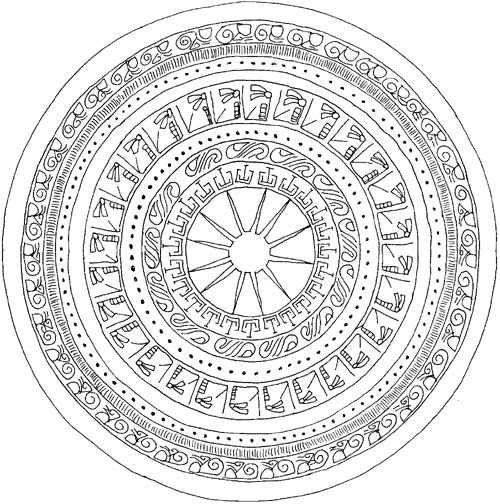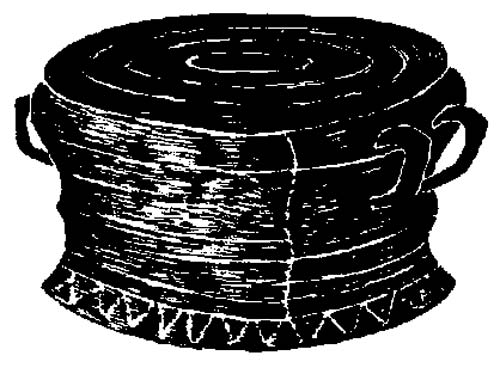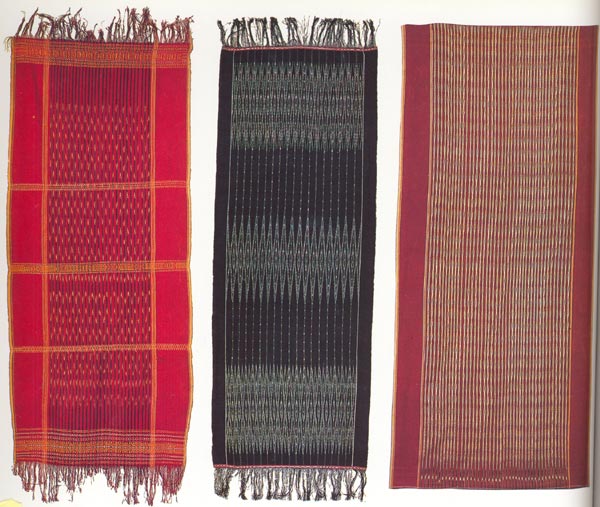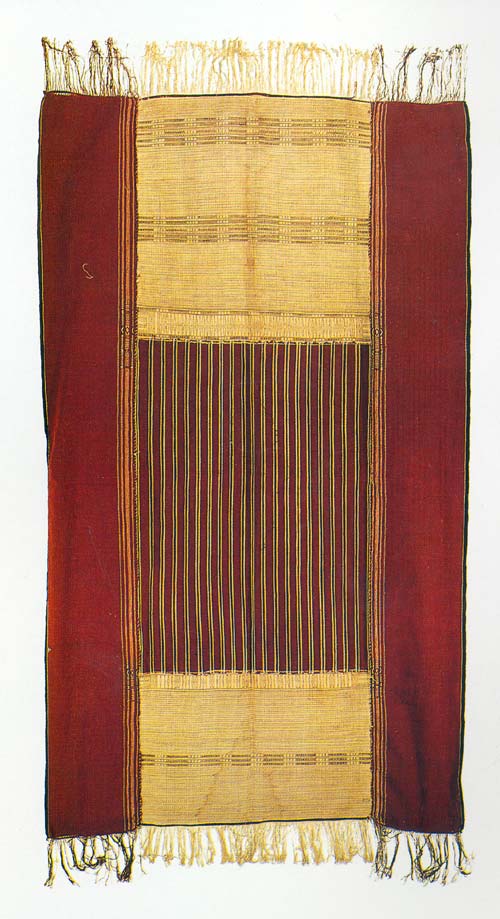





 |
|
 |
|
 |
|
 |
|
 |
|
|
|
 |
An ancient bronze kettle drum (face, side view and motifs) from the Dong-Son region of northern Vietnam, collected in south-western China in the 1920s.
Between the eighth and second century BC, because of military pressure from China, there was a large-scale migration from the Annam region of northern Vietnam, bringing to Indonesia a culture known to historians as the Dong-Son, which was to have a tremendous impact on the archipelago. It is widely believed that the backstrap continuously warped loom arrived with the Dong-Son, as did the art of warp-ikat. The Dong-Son were masters of bronzework and used bronze kettle drums in their rituals. On these drums were designs of the soul ship, the tree of life and the geometric patterns of the rhomb and key, spirals, sunbursts and human and animal forms that were to be diffused widely through the islands and to reappear as textile designs. Many of these are still in use in places as geographically separate as Sumatra and Timor. A fresh wave of migration from south China brought to Indonesia a culture known as the Late Chou, which introduced certain asymmetric designs and had particular influence in Borneo. The Bataks of north Sumatra, the Toraja of central Sulawesi, the Dyaks of Borneo and the islanders of east Nusa Tenggara and the southern Moluccas were to be largely unaffected by later foreign cultural influences, however, but continued to weave warp ikat textiles out of rough homegrown cotton with Dong-Son-inspired designs, dyed with locally gathered dyestuffs.
“The use of these ritual cloths is particularly prevalent amongst what textile scholars Warnming and Gaworski call the ‘ancient peoples of the archipelago’ encompassing amongst others, the Bataks, the Toraja, the Iban Dyaks, the Sumbans, the Timorese, the Nias islanders and the people of the Kroe-Lampung region in Sumatra. Some of the most striking textiles of the archipelago were created by the ‘ancient peoples’ for ceremonial use, often to define a ritual area and motifs symbolizing death can appear in these cloths.”
A graphic of a twining end to an ulos is at the top of page 73.
Weft-twined border from a warp-ikat ulos made by the Toba Batak, north Sumatra.
Warp ikat
Warp ikat is primarily the preserve of the 'ancient peoples', the builders of megaliths - those groups, animist in spirit, isolationist by inclination, whose legacy from the Dong Son culture was preserved either in the rugged mountainous interiors of the main islands, or on the outlying islands. These peoples were largely unaffected by the cultural and religious changes constantly sweeping through the coastal regions athwart the great trade routes.
Women of these cultures weave sarongs and selendangs on backstrap looms during the quiet hours of the heat of the day, in the shelter of the recess under their stilted houses. Young girls will learn the simpler techniques on small looms, leaving the finer weaving to their mothers and grandmothers. Traditionally the colours came from a wide variety of vegetable dyes, the most valued colours coming from the scarcest dye materials.
The Bataks
The Bataks live around the Lake Toba region of north Sumatra, and are noted practitioners of the warp-ikat technique. The Batak ulos cloths are usually vertically striped in muted sombre colours of blues, browns and magentas, with ikatted arrowheaded patterns. The vertically striped patterns look striking as the selendangs are most usually worn folded and pleated over the shoulder.
The Bataks are a large ethnic group of approximately three million who farm the fertile valleys of the highlands of north-central Sumatra. They are famed for their fierce independence, for their spectacular boat-shaped carved wooden houses, and for their warp-ikat textiles. Their culture is centred around the great, still Lake Toba and the sacred island of Samosir which lies within it. The Bataks are divided into six groups who speak different but related languages. The Angkola and Mandailing to the south, who were Islamicized during the Padri Wars of the mid-nineteenth century, the Toba from the Lake Toba region, who were converted to Christianity by Protestant German missionaries from 1864 on, and to the north the Pakpak/Dairi, the Simalungun and the Karo, who are now mostly Christian, although some are Muslim. Elements of the ancient Batak religion linger on, however, particularly amongst the Karo.
Though Western-style dress is prevalent in the Batak area, especially amongst the men, the traditional ulos rectangular cloths decorated with simple warp-ikat or extra-weft patterns (and sometimes with both) are essential wear at weddings and funerals. Ulos cloths are also prescribed articles in the complex series of gift exchanges that takes place at these and other important ceremonies that mark rites of passage.
The most significant ritual cloth is the ulos ragidup. At weddings the ulos ragidup ('the cloth with the pattern of life') is presented by the father of the bride to the mother of the groom. This both emphasizes the superior status of the bride-givers and confirms that the two sides of the new family are now inextricably linked. The ulos ragidup is a large selendang with the dark borders in plainweave and a central field of warp stripes or simple arrowhead warp-ikat patterning. This is attached at the top and bottom to two sections of complex extra-weft patterning on a white background, either by sewing, or by attaching new warps to those of the central field and continuing the weaving process. The narrow borders are woven separately and then sewn on to form a rectangular cloth. The ends of the ulos are finished off with weft twining in fine geometric patterning.
A selendang with the ragi hotang rattan pattern is given to the bridegroom and the ulos sibolang, a blue textile with lateral bands of warp-ikat patterning, is given by the bride-givers to the family of the groom. The sibolang is also an important funeral gift and is worn as a head cloth by the widow. Ulos may be worn as shouldercloths, sarongs or head cloths, and it is often the colour rather than the patterning that is symbolically important. White can mean purity, red bravery and black eternity. Ulos of blue or red are used to cover the deceased.
The centres for warp-ikat weaving
are in the Porsea area on the southern shores of Lake Toba, around the village
of Tarutung. Batak warp-ikat textiles are woven on horizontal, continuously
warped backstrap body-tension looms. Dyes were traditionally of vegetable origin
- the Batak were reputed to take up to ten years of successive dyeing to achieve
the right shade of indigo and made much use of Morinda citrifolia yarn
having previously been soaked in buffalo fat to help the red morinda dye adhere.
Patterning in Batak textiles is achieved by alternating different-coloured sections
of ikat. Another method can be used after dyeing, whereby the ikat-tied sections
are undone; the appropriate warp threads are then manipulated and pulled forward
so that an arrowhead formation is achieved.
The weavers around Lake Toba are the sole remaining practitioners of hand-loom
weaving. They can weave not only in the Toba style, but will also produce cloths
in the style of the Karo, Simalungun and Angkola Batak, to be sold in their
local markets.

Fig 109 Warp-ikat ritual ulos cloth made by the Toba Batak of Sumatra.
Fig 110 Toba Batak ulos sibolang decorated with three bands of warp-ikat patterning against a blue background. This textile is worn as a headdress by a widow.
Fig 111 Toba Batak ulos mangiring, used as a baby sling and patterned with warp-ikat arrowhead motifs.

The most spectacular motif worked, particularly on the palepai, is that of a ship with a great curving prow and stern, crammed with human figures and with a mast which often branches out into a tree of life. The idea of a ship of the dead, carrying souls away to the after-life, was once common throughout Indonesia, South-East Asia and the Pacific islands. Indeed wood-carved ships of the dead were a central theme in the art of the Batak of Sumatra and certain Dayak groups in Kalimantan.
All over the archipelago beads, seeds and shells which all have an intrinsic value have often been applied to cloth. In Lampung, beadwork was sometimes used as a substitute for weaving to make tampan and palepai. It was also once common on the textiles of the Toraja, the Bataks and the Dyaks, and was found in Sumba and Flores.
Sumatra is separated from neighbouring west Malaysia by the Straits of Malacca. Vast and relatively sparsely populated, it is the Indonesian island most richly endowed with natural resources. Having long-standing trading connections with India, China, Europe and Arabia, Sumatra is home to many distinct ethnic groups and boasts the most diverse textile tradition of the whole archipelago. The Islamic Acehnese, the highland Batak, the matrilineal Minangkabau, the Malays of the eastern coast and the tribal groups of pepper-rich Lampung produce a wide variety of silk and cotton textiles in the techniques of warp and weft ikat, supplementary-weft weaving, metal-thread embroidery, plangi, tritik, and a distinctive style of batik.

Fig 150 The ulos-ragidup is ritually the most important
of Batak textiles. Woven in three sections, the end panels are embellished with
fine supplementary-weft patterning.